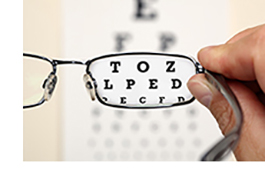|
CLICK HERE TO READ MORE
 What Does The Term 20/20 Vision Really Mean? What Does The Term 20/20 Vision Really Mean?
Everyone is familiar with the standard of vision called “20/20 vision”. We think that it is the level we need to achieve when wearing eyeglasses or contacts.
When asked this question, Dr. Neal Sher replied, “A person with 20/20 vision can see what an average individual can see on an eye chart when they are standing 20 feet away. An eye chart is used to measure visual acuity, which is the clarity or sharpness of vision. The top number of the 20/20 phrase refers to your distance in feet from the chart. The bottom number indicates the distance at which a person with normal eyesight can read the same line.”
When a patient is told that they have 20/30 vision, it means that their vision is worse than average. When they are standing 20 feet from the chart, they can read letters that most people see when they are 30 feet away.
Despite most people’s perception however, 20/20 vision is not perfect vision. Some people have 20/15 vision, which is sharper than average. If you have 20/15 vision, you can see a line in the eye chart at 20 feet that the average person can only see when they are 15 feet away. In general, the goal of correcting vision with glasses or contacts is to bring a person’s vision to 20/20.
Only about 35 percent of all adults have 20/20 vision without glasses, contact lenses or corrective surgery. With corrective measures, approximately 75 percent of adults have 20/20 vision. In almost every state, visual acuity of 20/40 or better is required for an unrestricted driver’s license. People are considered “legally blind” if their corrected vision (with eyeglasses or contacts) is 20/200 or worse.
The American Academy of Ophthalmology recommends that visual acuity be tested as soon as a child is old enough to cooperate with an eye exam using an eye chart. Some children lose their 20/20 vision around age 8 or 9. After that age, most people’s visual acuity stays stable. It may decrease slightly as people reach their 60s or 70s.
When people reach middle age, their visual acuity will probably not change, but they may lose their near vision. The eyes' lenses become less flexible and it becomes harder to change focus from objects that are far away to close objects. This is called presbyopia. Many people need reading glasses or bifocals to correct the problem.
Your visual acuity is measured as part of an eye exam. The American Academy of Ophthalmology recommends that you get a baseline eye examination at age 40, the time when early signs of disease or changes in vision may occur.
Article adapted from the AAO.org website.
|


